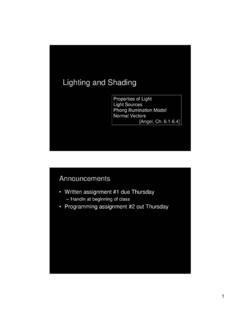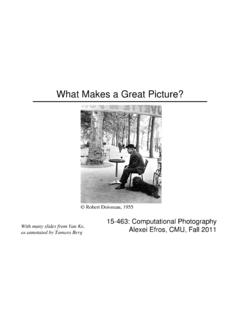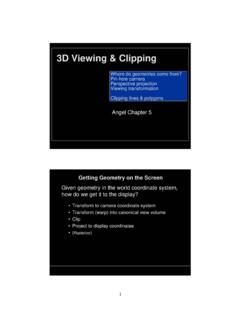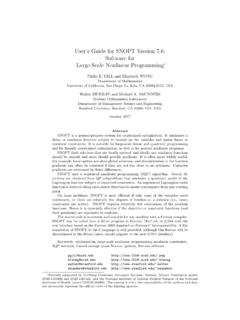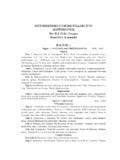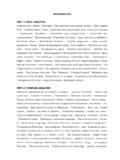Transcription of Questions on Assignment 1? - Computer graphics
1 1 Announcements Is your account working yet? Watch out for ^M and missing newlines Assignment 1 is due next Thursday at midnight Check the webpage and newsgroup for answers to Questions about the Assignment Questions on Assignment 1?TransformationsVectors, bases, and matricesTranslation, rotation, scaling Postscript ExamplesHomogeneous coordinates3D transformations3D rotationsTransforming normalsNonlinear deformationsVectors, bases, and matricesTranslation, rotation, scaling Postscript ExamplesHomogeneous coordinates3D transformations3D rotationsTransforming normalsNonlinear deformationsAngel, Chapter 42 Uses of Transformations Modeling transformations build complex models by positioning simple components transform from object coordinates to world coordinates Viewing transformations placing the virtual camera in the world specifying transformation from world coordinates to camera coordinates Animation vary transformations over time to create motionWORLDOBJECTCAMERAG eneral TransformationsQ = T(P)for pointsV = R(u)
2 For vectors3 Rigid Body TransformationsRotation angle and line about which to rotateNon-rigid Body Transformations4 Background Math: linear Combinations of Vectors Given two vectors, A and B, walk any distance you like in the A direction, then walk any distance you like in the B direction The set of all the places (vectors) you can get to this way is the set of linear combinations of A and B. A set of vectors is said to be linearly independentif none of them is a linear combination of the = v1A + v2B, (v1,v2) ABVB ases A basisis a linearly independent set of vectors whose combinations will get you anywhere within a space, spanthe space nvectors are required to span an n-dimensional space If the basis vectors are normalized and mutually orthogonal the basis is orthonormal There are lotsof possible bases for a given vector space; there s nothing special about a particular basis but our favorite is probably one of Represented in a Basis Every vector has a unique representation in a given basis the multiples of the basis vectors are the vector s components or coordinates changing the basis changes the components, but not the vector V = v1E1+ v2E2+.
3 VnEnThe vectors {E1, E2, .., En} are the basisThe scalars (v1, v2, .., vn) are the componentsof V with respect to that basisRotation and Translation of a Basis,,,6 linear and Affine Maps A function (or map, or transformation) F is lineariffor all vectors A and B, and all scalars k. Any linear map is completely specifiedby its effect on a set of basis vectors: A function F is affineif it is linear plus a translation Thus the 1-D transformation y=mx+bis not linear , but affine Similarly for a translation and rotation of a coordinate system Affine transformations preserve linesF(A+B) = F(A) + F(B) F(kA) = k F(A)V = v1E1 + v2E2 +v3E3 F(V) = F(v1E1 + v2E2 +v3E3)= F(v1E1) + F(v2E2) + F(v3E3)= v1F(E1) + v2F(E2) +v3F(E3)ABA+BTransforming a Vector The coordinates of the transformed basis vector (in terms of the original basis vectors): The transformed general vector V becomes:and its coordinates(still E) areor justThe matrix multiplication formula!
4 F(E1) = f11E1 + f21E2 +f31E3F(E2) = f12E1 + f22E2 +f32E3F(E3) = f13E1 + f23E2 +f33E3F(V) = v1F(E1) + v2F(E2) +v3F(E3)= (f11E1 + f21E2 +f31E3)v1 + (f12E1 + f22E2 +f32E3)v2 + (f13E1 + f23E2 +f33E3)v3= (f11v1 + f12v2 + f13v3)E1 + (f21v1 + f22v2 + f23v3)E2 + (f31v1 + f32v2 + f33v3)E3v1 = (f11v1 + f12v2 + f13v3)v2 = (f21v1 + f22v2 + f23v3)v3 = (f31v1 + f32v2 + f33v3)vi= fij6jvj7 Matrices to the Rescue An nxn matrix F represents a linear function in n dimensions i-th column shows what the function does to the corresponding basis vector Transformation = linear combination of columns of F first component of the input vector scales first column of the matrix accumulate into output vector repeat for each column and component Usually compute it a different way: dot row iwith input vector to get component iof output vector^`v1v2v3^` = f11f12f13f21f22f23f31f32f33^`v1v2v3vi= fij6jvjBasic 2D TransformationsTranslateScaleRotateParam eters t, s, and T are the control knobs x x txy y tyx y xy txty x x tx sxxy syyx y sx00sy xy x Sxx xcosT ysinTy xsinT ycosTx y cosT sinTsinTcosT xy x Rx8 Build compoundtransformations by stringing basic ones together, translate p to the origin, rotate, then translate back can also be described as a rotation about p Any sequence of linear transformations can be collapsed into a single matrix formed by multiplying the individual matrices together This is good.
5 Can apply a whole sequence of transformation at onceCompound TransformationsTranslate to the origin, rotate, then translate gjk6kvk= 6k fijgjk6jvkmij= fijgjk6jPostscript (Interlude) Postscript is a language designed for Printed page description Electronic documents A full programming language, with variables, procedures, scope, looping, .. Stack based, instead of 1+2 you say 1 2 add We ll briefly look at graphics in Postscript elegant handling of 2-D affine transformations and simple 2-D graphics92D Transformations in Postscript, 10 0 moveto(test) showtest1 0 translate0 0 moveto(test) showtest30 rotate0 0 moveto(test) showtest2D Transformations in Postscript, 21 2 scale0 0 moveto(test) show1 0 translate30 rotate0 0 moveto(test) show30 rotate1 0 translate0 0 moveto(test) showtesttesttest102D Transformations in Postscript, 330 rotate1 2 scale0 0 moveto(test) show1 2 scale30 rotate0 0 moveto(test) show-1 1 scale0 0 moveto(test) showtesttesttestHomogeneous Coordinates Translation is not linear --how to represent as a matrix?
6 Trick: add extra coordinate to each vector This extra coordinate is the homogeneouscoordinate, or w When extra coordinate is used, vector is said to be represented in homogeneous coordinates Drop extra coordinate after transformation (project to w=1) We call these matrices HomogeneousTransformationsx y 1 10tx01ty001 xy1 11W!? Where did that come from? Practical answer: W is a clever algebraic trick. Don t worry about it too much. The w value will be for the time being. If w is not , divide all coordinates by w to make it so. Clever Academic Answer: (x,y,w) coordinates form a 3D projective space. All nonzero scalar multiples of (x,y,1) form an equivalence class of points that project to the same 2D Cartesian point (x,y). For 3-D graphics , the 4D projective space point (x,y,z,w) maps to the 3D point (x,y,z) in the same 2D TransformationsThe basic 2D transformations becomeTranslate:Scale:Rotate:Any affine transformation can be expressed as a combination of can combine homogeneous transforms by anysequence of translate/scale/rotate operations can be collapsed into a single homogeneous matrix!
7 10tx01ty001 sx000sy0001 cosT sinT0sinTcosT0001 12 Postscript and OpenGL TransformationsPostscript30 rotate1 0 translatedraw somethingEquivalent OpenGLglRotatef(30, 0,0,1);// rot 30 about z axisglTranslatef(1,0,0);draw something0 ,1 ,30 case in this110010011000cossin0sincos1 q yxyxttyxttyxTTTTT(x ,y )coord. sys.(x,y)coord. of TransformationsMMMxxxxxxxxxxx x x x x x x x x PARAMETERSMATRICESUNTRANSFORMED POINTSTRANSFORMED POINTS Often the same transformations are applied to many points Calculation time for the matrices and combination is negligible compared to that of transforming the points Reduce the sequence to a single matrix, then transform13 Collapsing a Chain of Matrices. Consider the composite function ABCD, p = ABCDp Matrix multiplication isn t commutative - the order is important But matrix multiplication is associative, so can calculate from right to left or left to right: ABCD = (((AB) C) D) = (A (B (CD))).
8 Iteratively replace either the leading or the trailing pair by its product Postmultiply: left-to-right (reverse of function application.) Premultiply: right-to-left (same as function application.) Postmultiply: left-to-right (reverse of function application.) Premultiply: right-to-left (same as function application.)M mDM mCMM mBMM mAMM mAM mMBM mMCM mMDorboth give the same Transformation Sequences Calculate the matrices and cumulatively multiply them into a global Current Transformation Matrix Postmultiplication is more convenient in hierarchies -- multiplication is computed in the opposite order of function application The calculation of the transformation matrix, M, initialize M to the identity in reverse order compute a basic transformation matrix, T post-multiply T into the global matrix M, M mMT Example - to rotate by Taround [x,y]: Remember the last T calculated is the first applied to the points calculate the matrices in reverse orderglLoadIdentity() /* initialize M to identity mat.
9 */glTranslatef(x, y, 0) /* LAST: undo translation */glRotatef(theta,0,0,1) /* rotate about z axis */glTranslatef(-x, -y, 0) /* FIRST: move [x,y] to origin. */14 Column Vector Convention The convention in the previous slides transformation is by matrix times vector, Mv textbook uses this convention, 90% of the world too The composite function A(B(C(D(x)))) is the matrix-vector product ABCDxx y 1 m11m12m13m21m22m23m31m32m33 xy1 Beware: Row Vector Convention The transpose is also possible How does this change things? all transformation matrices must be transposed ABCDx transposed is xTDTCTBTAT pre- and post-multiply are reversed OpenGL uses transposed matrices! You only notice this if you pass matrices as arguments to OpenGL subroutines, glLoadMatrix. Most routines take only scalars or vectors as y 1> @ xy1> @m11m21m31m12m22m32m13m23m33 15 Rigid Body Transformations A transformation matrix of the formwhere the upper 2x2 submatrix is a rotation matrix and column 3 is a translation vector, is a rigid body transformation.
10 Any series of rotations and translations results in a rotation and translation of this formxxxytxyxyyty0 0 1 Viewport Transformations A transformation maps the visible (model) world onto screen or window coordinates In OpenGL a viewport transformation, glOrtho(), defines what part of the world is mapped in standard Normalized Device Coordinates ((-1,-1) to (1,1)) The viewpoint transformation maps NDC into actual window, pixel coordinates by default this fills the window otherwise use glViewport(2,0)( ,2)(0,0)(640,480)163D Transformations 3-D transformations are very similar to the 2-D case Homogeneous coordinate transforms require 4x4 matrices Scaling and translation matrices are simply: Rotation is a bit more complicated in 3-D left- or right-handedness of coordinate system affects direction of rotation different rotation axesS = s00000s10000s200001T = 100t00 1 0t10 0 1t20001 Right-handed vs.
